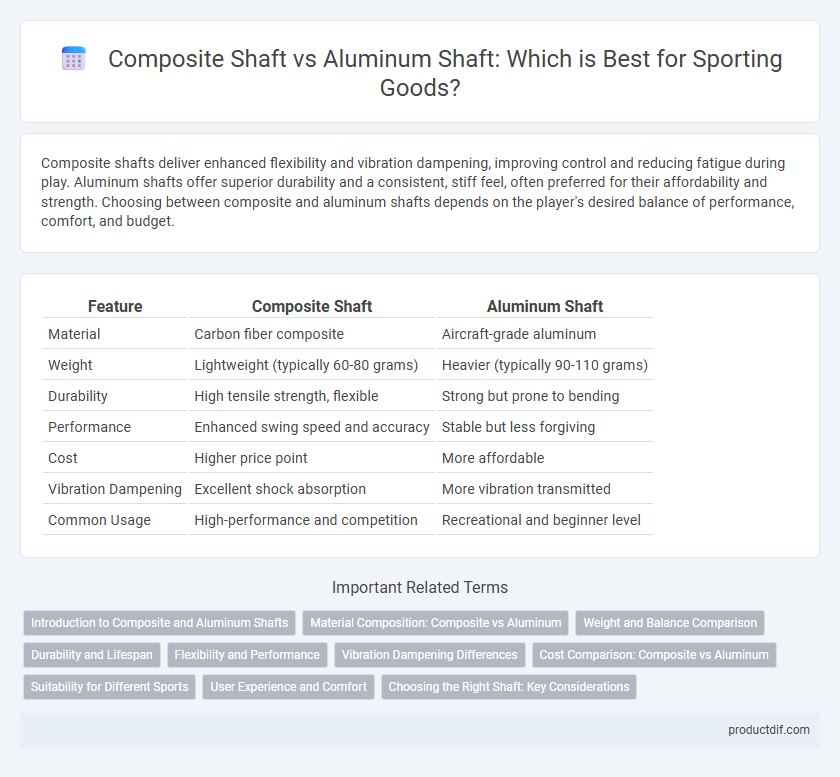Composite shafts deliver enhanced flexibility and vibration dampening, improving control and reducing fatigue during play. Aluminum shafts offer superior durability and a consistent, stiff feel, often preferred for their affordability and strength. Choosing between composite and aluminum shafts depends on the player's desired balance of performance, comfort, and budget.
Table of Comparison
| Feature | Composite Shaft | Aluminum Shaft |
|---|---|---|
| Material | Carbon fiber composite | Aircraft-grade aluminum |
| Weight | Lightweight (typically 60-80 grams) | Heavier (typically 90-110 grams) |
| Durability | High tensile strength, flexible | Strong but prone to bending |
| Performance | Enhanced swing speed and accuracy | Stable but less forgiving |
| Cost | Higher price point | More affordable |
| Vibration Dampening | Excellent shock absorption | More vibration transmitted |
| Common Usage | High-performance and competition | Recreational and beginner level |
Introduction to Composite and Aluminum Shafts
Composite shafts in sporting goods are made from advanced materials like carbon fiber, offering lightweight strength and enhanced flexibility for improved performance. Aluminum shafts provide durability and affordability, with a heavier weight that delivers increased stability and power transfer. Both materials cater to different playing styles, balancing factors such as weight, strength, and cost-effectiveness.
Material Composition: Composite vs Aluminum
Composite shafts combine carbon fiber, fiberglass, and resin, offering superior flexibility, vibration dampening, and lighter weight compared to aluminum shafts, which are made from a single, lightweight metal alloy known for durability and affordability. The material composition of composite shafts allows for enhanced energy transfer and customized stiffness profiles, while aluminum shafts provide consistent strength and resistance to bending under high stress. Choosing between composite and aluminum depends on performance preferences, with composites favored for precision and feel, and aluminum preferred for ruggedness and budget-friendliness.
Weight and Balance Comparison
Composite shafts in sporting goods like golf clubs or baseball bats offer a lighter weight compared to aluminum shafts, enhancing swing speed and control. The advanced materials in composite shafts provide superior balance by distributing weight more evenly, resulting in improved feel and performance. Aluminum shafts tend to be heavier and less flexible, which can affect the overall balance and lead to a less responsive experience during play.
Durability and Lifespan
Composite shafts in sporting goods offer superior durability and a longer lifespan compared to aluminum shafts due to their resistance to corrosion and fatigue. Aluminum shafts are prone to bending and cracking under repeated stress, reducing their overall longevity in sports equipment. The enhanced tensile strength of composite materials ensures consistent performance over extended periods, making them a preferred choice for durability-focused athletes.
Flexibility and Performance
Composite shafts deliver superior flexibility compared to aluminum shafts, allowing for enhanced energy transfer and improved swing speed. This increased flex results in better performance, especially for players seeking greater distance and accuracy in their shots. Aluminum shafts, while more rigid, provide durability but lack the responsive flex that composite materials offer for optimized sporting performance.
Vibration Dampening Differences
Composite shafts provide superior vibration dampening compared to aluminum shafts due to their layered fiber construction, which absorbs and distributes shock more effectively. Aluminum shafts tend to transmit more vibrations to the hands, potentially causing discomfort or fatigue during prolonged use. Enhanced vibration dampening in composite shafts improves overall comfort and control for athletes using sporting equipment like golf clubs and baseball bats.
Cost Comparison: Composite vs Aluminum
Composite shafts generally have a higher upfront cost compared to aluminum shafts due to advanced materials and manufacturing processes enhancing performance and durability. Aluminum shafts offer a more budget-friendly option with lower production expenses, making them popular for recreational and entry-level clubs. Despite the initial price difference, composite shafts can provide better long-term value through improved playability and resistance to wear.
Suitability for Different Sports
Composite shafts offer enhanced flexibility and vibration dampening, making them ideal for sports like golf and hockey where precision and control are critical. Aluminum shafts provide greater durability and stiffness, better suited for sports such as baseball and lacrosse where impact resistance and power are essential. Selecting the appropriate shaft depends on the specific sport's performance demands and the athlete's playing style.
User Experience and Comfort
Composite shafts in sporting goods offer superior vibration dampening and enhanced flexibility, resulting in a smoother and more comfortable user experience during extended play. Aluminum shafts are generally stiffer and heavier, which may cause increased hand fatigue and reduced comfort over time. Users seeking better shock absorption and a more forgiving feel often prefer composite shafts for improved overall comfort.
Choosing the Right Shaft: Key Considerations
When choosing the right shaft for sporting goods, consider factors such as weight, durability, and flex. Composite shafts offer lighter weight and increased flexibility, enhancing swing speed and control, while aluminum shafts provide greater strength and consistency at a lower cost. Assessing performance needs and budget will help determine the optimal choice between composite and aluminum shafts.
Composite shaft vs Aluminum shaft Infographic

 productdif.com
productdif.com